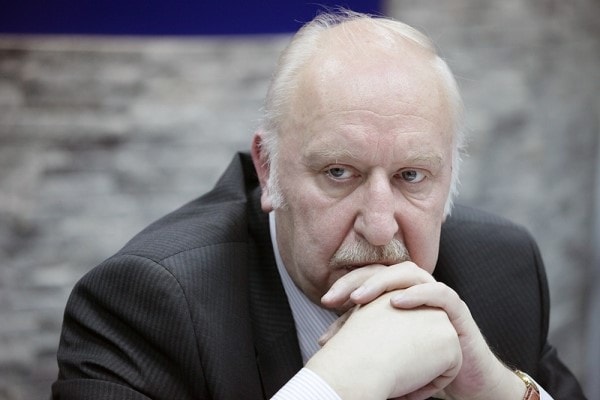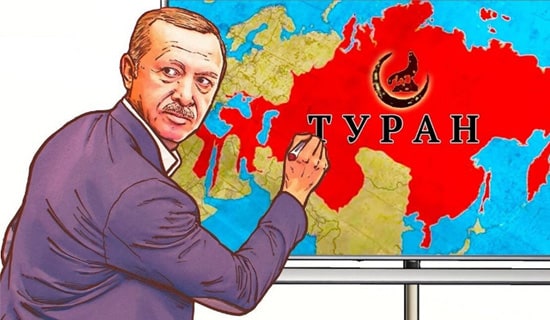A simple calculation conducted by Moskovski Komsomolets correspondent George Stepanov blows up the government's contention that food price inflation is not a major concern as Russia's citizens are compensated via indexing of salaries and pensions. Relying solely on official statistics, Stepanov found that in terms of food purchases, the indexing has not kept pace with inflation. The recovery of oil and gas prices has not helped the Russian consumer as profits are diverted to the National Welfare Fund, an institution that Stepanov considers hopelessly misnamed.
Stepanov's article follows below:[1]

Russian consumer experiences sticker shock (Source: Rbc. Ru)
"Food price inflation in Russia is gaining momentum. Nevertheless, the authorities claim that there is no inherent catastrophe, because Russians' wages and pensions are regularly indexed. However, the officials are stubbornly silent about the situation with real disposable income, which for eight years has been trending downward. We decided to look at how much food prices have risen compared to people's incomes. Furthermore, we compared prices over a 10-year period, from 2011 to 2021, and not merely over the last year or two, so that the picture wouldn't come out distorted due to the coronavirus crisis and lockdowns.
"To ensure an uncontaminated experiment, we used only official data from Rosstat [Federal State Statistics Service] (excluding alternative sources), and only the national average. After all, prices can vary greatly in different regions and even in different stores in the same region.
"So, back in 2011, Russia had not yet fully emerged from the terrible crisis of 2008-2009, however the GDP growth had already reached the pre-crisis rate. The oil price was going up, taxes were collected more actively, and there was a record-breaking harvest of sugar beets, sunflowers, and vegetables. Retail trade revived, as people began to spend more money on goods.
"But people came out of austerity mode not because they started to earn more, but thanks to their previously accumulated savings and loans. The average salary back then was 23,369 rubles (today it's 53,700 rubles), the average pension was 8278 rubles (today - 17,500), and the average annual dollar exchange rate [to the ruble] was 29.4 rubles per USD (today it's 71 rubles).
"And now for the best part. Let's compare food prices between 2011 and currently (according to Rosstat data). In general, the food prices were significantly lower than that today. There are two exceptions: buckwheat, a kilogram of which back in 2011 was sold at a price of 112.02 rubles (now it costs 99.27 rubles) due to the poor harvest, and white cabbage (which costed 38.1 rubles [per kilogram] back then, and now costs 33.04 rubles).
"Butter, 247.7 rubles per kilogram; it costs 655.3 rubles now (a 164% increase)
Chicken eggs, 10 eggs cost 35.1 rubles; the dozen cost 80.6 rubles (a 129.8% increase)
"Rye flour bread, 27.8 rubles per kilogram; now - 58.2 rubles (a 109.4% increase)
"Fat cottage cheese, 172.7 rubles per kilogram; it costs 359.6 rubles (a 108.1% increase)
"Wheat flour, 21.3 rubles per kilogram; it costs 48 rubles (a 101.8% increase)
"Bread made from wheat flour, 44.5 rubles per kilogram; now - 87 rubles (a 95.5% increase)
"Bananas, 46.1 rubles per kilogram; now - 88 rubles (a 91% increase)
"Pasteurized milk, 31.8 rubles per liter; it costs 59.6 rubles (a 87.4% increase)
"Pasta, 46.7 rubles per kilogram; it costs 87.2 rubles now (a 86.9% increase)
"Boneless beef, back in 2001 it cost 313,9 rubles; in 2021- 532.6 rubles (a 69.7% increase)
"Tomatoes, 87.3 rubles per kilogram; now - 148.2 rubles (a 69.6% increase)
"Sunflower oil, 78.1 rubles per liter, now it costs 130.5 rubles (a 67% increase)
"Apples, 71 rubles per kilogram; they cost 113.1 rubles (a 59.3% increase)
"Carrots, 37.9 rubles per kilogram; now - 59.4 rubles (a 56.7% increase)
"Cucumbers, 91,6 rubles per kilogram; now - 134,3 rubles (a 46,7% increase)
"Potatoes, 34,5 rubles per kilogram; now they cost 47,2 rubles (a 36,9% increase)
"Sugar 39.6 rubles per kilogram; now - 50.5 rubles (a 27.5% increase)
"Buckwheat, 112 rubles per kilogram; it costs 99.2 rubles now (a 11.4% decrease)
"White cabbage, 38.1 rubles per kilogram; it costs 33 rubles (a 13.3% decrease)
Objective And Artificial Factors
"These price increases wouldn't amount to anything if the citizens' welfare did not hopelessly lag behind this impressive dynamic, and did not run counter to it. According to Rosstat estimates, in the first quarter of 2021 the real disposable income per citizen was about 32,612 rubles. We will use this figure, as well as the corresponding indicator of ten years ago (20,780 rubles), because it, unlike wages and pensions, applies to all citizens without exception.
"Let's calculate the number of weight units of different food items, which can be purchased for these amount [in 2021 and back in 2011]. Take, for example, chicken eggs. In order to get the figure for 2011, we divide 20780 by 35 (the price per dozen), and get 593.7. In order to get the figure for 2021, we divide 32612 by 80.6, and get 404.6.
"In other words, 10 years ago, the average disposable income allowed to purchase 593 standard packs of a dozen eggs, but today – 404 packs. Here are our results for other products.
"What could be bought with average disposable income in 2011 and in 2021
"Butter: 83.8 / 49.7 kilogram
"Wheat flour: 973.7 / 679.4 kilogram
"Rye bread: 747.4 / 560.3 kilogram.
"Accordingly, a Russian will now be able to prepare half as less the number of standard sandwiches with butter on his average income than [he could] a decade ago.
"Pasteurized milk: 653.4 / 547.1 liters
"Fat cottage cheese: 120.3 / 90.6 kilogram
"Pasta: 444,9 / 373,9 kilogram
"Boneless beef: 66,1 / 54,9 kilogram
"Olive oil: 40,5 / 30,4 liters
"Bananas: 451,7 / 370,5 kilogram
"This gap facilitates an understanding of how the purchasing power of citizens changed over the decade. On average It decreased by a factor and a half in relation to basic food products.
Oil And Gas Are Not For Us
"According to Elena Tyurina, a member of the Agricultural Committee of the Chamber of Commerce and Industry, since 2011, the citizens' real disposable income has increased by half (by 50%), while the retail price of the very same fruit and vegetable products has risen by an average of 70%.
"Today, as Tyurina stated, the demand for fruits and vegetables is decreasing, because, first, they have increased in price ([an increase] that is no longer seasonal in nature), and second, households have to spend more and more money to pay for utilities and the purchase of gasoline.
"Whereas, 10 years ago, 70% of food and vegetable goods were imported during the winter months, even the "borscht component set" (i.e. potatoes, cabbages, beets, carrots) and greenhouse vegetables, not only bananas, kiwi, mangoes and other tropics-grown products. Today, according to Tyurina's estimates, the share of imported agricultural products has fallen to 40-45%, as domestic investors have put more assets into construction of greenhouses and vegetable storage facilities since 2014.
"However, no import substitution, no greenhouses and no state subsidies to farmers salvage the situation. Otherwise average retail prices wouldn't rise by dozens of percent. The reason for it are the factors which the Russian authorities cannot deal with, (or don't want to?)
"'Since 2011, the dollar exchange rate to ruble has risen from 30 rubles per USD to more than 70 rubles per USD. Many components for industry and consumable materials, as well as raw materials and technology, are still being acquired for foreign currency. In addition, labor expenses have increased by about 30-35%. Logistics, raw materials, packaging, advertising have risen significantly too ...
"'As for the people's real incomes, they in today's Russia are lagging 5 to 10% behind the growth of consumer prices,' noted Anna Bodrova, Senior Analyst at the Alpari IAC [Information and analysis center].
"Even the current high oil and gas prices, Russia's main exports, cannot boost the population's purchasing power. After all, whatever the energy prices are, Russians derive absolutely nothing from them, they keep living effectively just as when the oil price was 42.4 USD per barrel, argued financial analyst Sergei Drozdov. According to the Budget rule, all extra oil and gas revenues beyond the government established price (42.4 USD per barrel) are allocated to the National Welfare Fund.
"According to the analyst, it is high time to rename this financial 'cushion' of the government, because since the creation of the National Welfare Fund in 2008, the welfare of citizens is only deteriorating. The expert also recalls that the collapse of the ruble exchange rate back in 2014-2015 didn't lead to a substantial increase in food prices. Back then the rise in prices was curbed by large retail chains, which forced their terms onto suppliers.
"But this method no longer works today. On top of everything else, in those years, producers enjoyed higher margins. Thus, they squeezed their own profits as best they could without touching prices, to avoid scaring off consumers. But now all their resources have been exhausted.
"Drozdov also considers a steady rise in the cost of gasoline to be a powerful long-term driver of food prices. The gasoline price, regardless of the oil market situation has never decreased over the past decade. In turn, this prompted an increase in the share of transport costs in goods production, marketing finished products, and harvesting.
"In 2019, the price tags in grocery stores were affected by another factor that appeared back then, i.e. an increase in the rate of the value-added tax (VAT) from 18 to 20%."
A Weak Ruble Is The Root Of All Evils
"'In order to understand why the population's purchasing power dropped, we must proceed from all the macroeconomic events that occurred in Russia and the world over the past decade," said Nikita Maslennikov, a leading expert at the Center for Political Technologies. According to him, the weak ruble remains the main inflation-inducing factor. Settlements with foreign suppliers are performed in dollars and euros. Therefore, when prices in foreign currency (including food products) skyrocket, this immediately affects domestic prices.
"'This is a rule set in stone, nothing can be done about it. Plus, the pandemic induced chaos. If not for it, the government would still be able to fight inflation just via standard monetary methods,' said Maslennikov. But, as history taught us, just raising the Central Bank's key rate now won't help. We have to use all the economic tools to the full extent.
"Regarding the comparison of food prices in 2011 and 2021, it is quite relative. One thing is clear, according to the expert, almost every year of the last decade the growth of food prices was higher than the general inflation rate. However, the assortment of the consumer basket has undergone profound change. The assortment has widened; the availability of goods has increased, many items of meat, poultry, milk, fruits and vegetables were added to the consumer basket. Largely due to this very reason, it is difficult to compare the purchasing power of Russians back in 2011 and today.
"According to Maslennikov, the situation with real disposable income, which is a universal indicator of the quality of life and the impact of economic growth, is much more indicative. Maslennikov said that since 2013, real disposable income, according to Rosstat calculation, decreased by more than 10%.

Nikita Maslennikov (Source: Rg.ru)
"Be that as it may, it's not so important how much (and for what groups of goods) food prices have risen over the past decade. The gap between their trend and the dynamics of citizen's income is much more important. The state left people facing this problem alone, which reached extremes in 2021, against the backdrop of galloping inflation. No matter what officials may say about this pricing mayhem, no matter how convincing and economically sound their excuses are, Russians won't get richer because of that. Millions of citizens still receive a salary of 30,000 rubles as it were in 2011.
"The average Russian family spends 44% of its income on groceries, while a family with children spends even more than that. In addition, one has to pay utilities, buy the most necessary drugs and pay for public transport.
"Thus, it turns out that with this composition of income and expenses of average Russian, an ordinary sandwich with butter is becoming a way more expensive delight for the country's citizens than it was 10 years ago. This was once again confirmed by a simple statistical experiment conducted by MK."

George Stepanov (Source: Mk.ru)
[1] Mk.ru, November 7, 2021.





